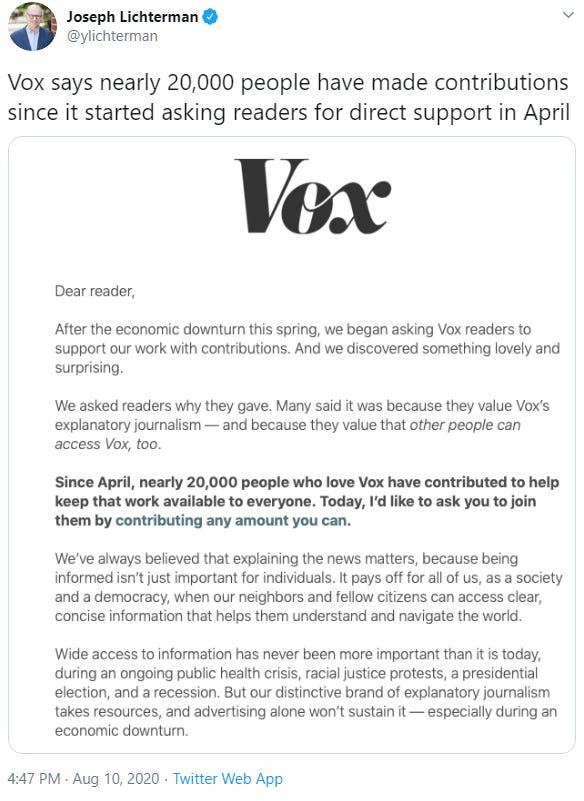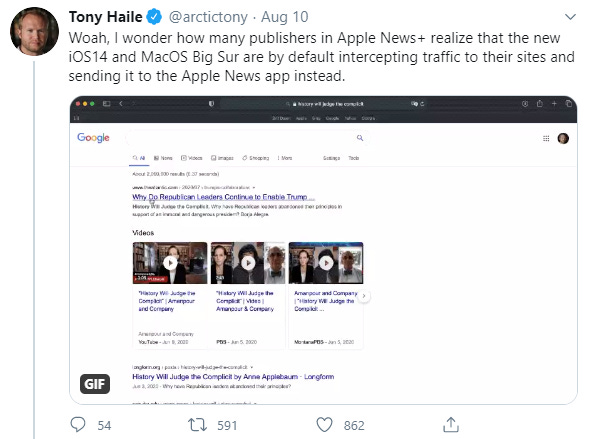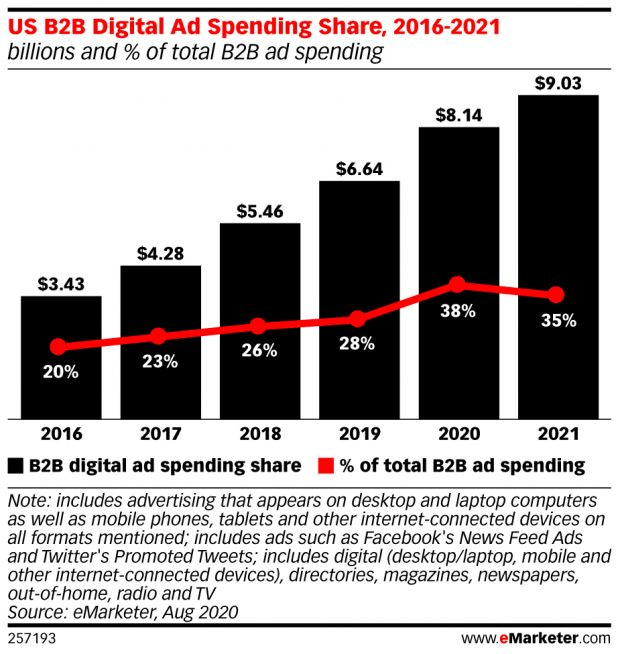In April, as companies were starting to grapple with the reality that advertising budgets likely going to stay depressed for some time, Vox took an unusual approach. Instead of racing to launch a subscription, it opted to introduce a contribution program.
At the end of every article, it would include this message:
Every day at Vox, we aim to answer your most important questions and provide you, and our audience around the world, with information that has the power to save lives. Our mission has never been more vital than it is in this moment: to empower you through understanding. Vox’s work is reaching more people than ever, but our distinctive brand of explanatory journalism takes resources — particularly during a pandemic and an economic downturn. Your financial contribution will not constitute a donation, but it will enable our staff to continue to offer free articles, videos, and podcasts at the quality and volume that this moment requires. Please consider making a contribution to Vox today.
Naturally, many people reacted negatively to this plea for assistance. Vox wasn’t the first, but it was one of the largest brands to deploy it. What was a massive, VC-backed media company doing taking money like that?
It’s crazy to think about, but most of the United States shut down five months ago. We’re obviously not out of this pandemic, but much of that initial shock is behind us. At the time, companies were moving fast and trying anything they could to generate revenue. It was that or layoffs.
In late March, I wrote:
Earlier this week, I wrote about how media companies that are feeling pressure to open their COVID-19 content might still be able to grow their subscription business with smart, benefit-driven calls to action.
That prompted a conversation with a founder friend of mine who was thinking about doing something similar. He explained that, if things got particularly bad, he would be inclined to do it. He asked me what I thought of that.
So, I told him the truth. I thought it was an idea worth trying.
Apparently, that was a controversial statement to the rest of media that he was speaking with. All of the other feedback he had received was that only hard news organizations can get away with that and that it would be a bad look for the brand.
A bad look for the brand… You know what’s a bad look for a brand? Going out of business. No one will remember the good takes or the bad takes; they’ll just remember that the brand went out of business, or worse, forget that the brand existed entirely.
We circle back to Vox. Whether it was right or wrong, it took an approach that it felt would help it survive above all else. I’m not going to fault that. That’s not the type of writer I am.
However, in an effort to learn from various approaches, I can’t help but feel as if it could have deployed a more efficient approach. Based on some marketing that is going around, the Vox contribution program is now boasting of nearly 20,000 contributions. Joseph Lichterman at the Lenfest Institute tweeted:
 |
For a publication as large as Vox—according to SimilarWeb, it generates 30.5M monthly visits—to only get 20,000 people to contribute in four months seems underwhelming. Without understanding how many of those are recurring versus one-time donations, it’s hard to know just how much money Vox is making. But for a company that did $185 million in revenue last year, it just seems low.
But that’s not actually very surprising. Whether you are launching a contribution program or a paywall, one of the most important things a publisher can do is actually promote the offering. Vox isn’t promoting this.
Other than a small story pinned to the homepage and then at the end of articles, it’s not easy to actually find the promotion. I’ve seen an occasional high-impact advertisement running. But as of writing this on Monday night, I see nothing.
This is curious because the company had recently added subscription DNA to the business. I wrote at the time:
New York Media used to make 85% of its revenue from advertising, but has been able to diversify enough into e-commerce (which Vox desperately needs) and subscriptions so that now only 60% of its revenue comes from advertising.
…
New York Media brings subscription chops to the table. It has figured out how to get people to pay for content, but like Benton said, there are only so many superfans. By making the network so much larger, you can likely convince more people to fork over some money to get access to a lot more content.
For generalist news publications, bundling is likely going to be one of the ways you can get subscription dollars. To be clear, I don’t mean bundling with Apple News+; I mean bundling with your own network of sites.
New York Media may not have been a juggernaut in the subscription business, but it was far enough along to understand what did and didn’t work. Therefore, it’s surprising that Vox didn’t get more aggressive with its contribution program—or, honestly, think about introducing some sort of a membership approach.
An argument I’ve heard against subscriptions is that it is very transactional. A membership, on the other hand, is about more than just the content. Could Vox, which purports to have built a community, have offered additional benefits—Q&As with journalists, exclusive podcasts, a bloody tote bag—in exchange for a recurring contribution?
Only Vox can answer that because only it really knows how its audience feels about the brand. However, I do have some thoughts on why it isn’t working.
As I said above, whether it’s subscriptions, memberships or just asking for donations, you have to be explicit about the ask. It needs to be in the readers face. They may not want to do it; that’s okay. It still needs to be in their face explicitly. With subscriptions, we call this the stoppage rate, which describes the number of articles a reader sees before the paywall appears. If a publisher has the stoppage rate set to 10 articles and then cuts it to 5, I guarantee the conversion rate will improve.
In the case of Vox, there appears to have been no strategy around how they were going to get people to sign up other than an article and a couple of emails announcing it. It feels as if Vox was embarrassed to ask for money.
If Vox does want this program to continue—and all signs point to that—then it needs to get more aggressive with the program. Here are three things I would deploy immediately and a fourth I’d strategize on:
House ads: It’s clear that the ad business is struggling. It’s promoting newsletters and other products across the network. Push the contributor program through house ads. By this point, Vox should know the % of people that will convert to a contribution, so it should be able to determine an eCPM for the house ad. Any ad paying below that eCPM, show the house ad. Any ad paying above it, show the contributor program.
Soft Paywall: Even if Vox does want to keep its content open for everyone, make it just the slightest bit more difficult for the reader and introduce a paywall. There can be a big ol’ X on it, but Vox needs to get the contributor program in front of people and use strong, benefit-driven copy to get users to understand the importance.
Improve End of Article Unit: If I wasn’t looking for it, I wouldn’t know it existed. It’s so subtle and blends right into the page. Like the paywall approach, readers’ eyes need to be drawn toward it. I wrote about how The Guardian did it and think that it’s a strong approach.
Go Membership Route: The truth is, Vox needs to take the experience New York Media provides and really lean into a membership of sorts. If it believes its explanatory journalism is important and its audience agrees, then move away from the contribution model and, instead, build something that users will really enjoy. This route will take longer, but it’ll also likely help the business longer-term.
The reality is, being subtle with the ask just doesn’t work. Readers can only act when they are presented with the offer. If Vox is serious about generating revenue from readers in this way, it needs to get over any apprehension it might feel and commit.
Apple intercepting traffic for News+
For another example of a platform going from being potentially friendly to slowly parasitic, I present (click for gif):
 |
Here’s what’s happening…
If a user has an Apple News+ subscription, the default setting for people that have iOS14 and/or MacOS Big Sur is to open Apple News+ whenever clicking a web link. In other words, if you’re on Google, click a story from a publisher that is part of Apple News+, you’ll be redirected to Apple.
This changes the narrative around what Apple News+ is supposed to be. Originally, it was billed as a separate channel that might provide incremental revenue. The people that subscribed to Apple News+ might never become subscribers to a specific publisher, so the new stream of cash might be worth it.
A publisher could always rest easy knowing that whenever someone found one of their articles through Google or some other source, the traffic would be directed straight to their owned & operated site.
Now, though, Apple News+ is a direct competitor to a publisher’s business. Even if it’s unlikely that a user become a paying subscriber to a publisher if they already have Apple News+, this basically removes the reader/publisher relationship entirely. A user reads content on Apple News+ and never actually visits the publisher. That’s a non-starter.
I wrote about The New York Times leaving Apple News recently:
“Core to a healthy model between The Times and the platforms is a direct path for sending those readers back into our environments, where we control the presentation of our report, the relationships with our readers, and the nature of our business rules,” Meredith Kopit Levien, chief operating officer, wrote in a memo to employees. “Our relationship with Apple News does not fit within these parameters.”
For publishers that are currently in Apple News+, it’s highly unlikely the revenue is worth giving up the entire relationship with a reader. Frankly, if I’m a publisher in Apple News+, I’m yanking my content from the network.
Before anyone says that the revenue is “worth it,” let’s just remember how many times we’ve been promised gobs and gobs of money, only to be left disappointed. A centralized bundle like this only helps Apple. It gets to keep 50% of all revenue irrespective of how many publishers are in the network.
If someone can make a compelling argument to stay in Apple News+ with this sort of behavior, I’m all ears. But I just don’t see the case.
B2B ad revenue growing
When Covid-19 first hit and there were stories being written about how the floor of the ad market had fallen, many of the B2B operators that I talk to kept saying, “not all ad businesses are struggling.”
Now we know why…
According to research by eMarketer and reported by The Drum, US B2B digital ad spend has increased by 22.6%.
B2B digital ad spend will hit $8.14bn, up 22.6% from 2019. Comparatively, US digital ad spend, as a whole, will only rise 1.7% this year, to $134.66bn.
Long reliant on events and traditional channels, “the conditions of Covid-19 are really forcing B2B marketers to realize that they need to accelerate their transformation into digital,” says Jillian Ryan, eMarketer principal analyst covering B2B and marketing transformation at Insider Intelligence.
Search, virtual event sponsorships, podcasts and spending on LinkedIn are replacing TV, print, out-of-home and in-person events, says Ryan. In fact, LinkedIn will secure a fifth of all B2B ad dollars in 2020. “They are the supreme social network in terms of share.”
Included in the report is this graphic that shows the growth:
 |
What’s quite remarkable is the fact that B2B ad spend is expected to rise to 38%, which is a sizeable chunk of the total ad market. No wonder the B2B readers of A Media Operator haven’t been as concerned as consumer publications.
According to eMarketer, where B2B publishers are finding much success is with bespoke webinars and “these virtual paid executions.” Another piece from the report:
What isn’t working as well? The darling of B2B marketers: account-based marketing. “How do you target those people when reverse IP address detection doesn’t work as well as it did when we were all in office? And as you know, cookies are going away. To prepare for this, B2B advertisers should be focused on growing their first-party data set.”
The logic behind all of this news is actually very straightforward. A large part of many B2B companies’ marketing is tied to physical events. I know marketers that spend a solid 50% of their time on the road. When events had to shut down, B2B companies needed to reallocate their budgets to new opportunities—digital advertising was the most obvious approach.
However, it’s more than just that. B2B advertising is also very much a results driven business. Unlike consumer media, which gets away with selling “branding,” if a business publisher isn’t driving leads, the advertiser will pull the budget. Therefore, many of the most successful publishers have very strong targeting to maximize the quality of leads.
We got a hint of this news a couple weeks ago when it was announced that Industry Dive had acquired the marketing arm of NewsCred. Fischer reported that:
At the time, its revenue was roughly $30 million, according to sources.
Today, Griffey says revenue is up significantly and that the business is highly profitable.
"Q2 was our best quarter in company history from both a revenue and profit standpoint," says Griffey.
That’s a good business if you ask me…
Thanks for reading today’s piece. For premium members, leave your thoughts in the comments below. If you have colleagues that would benefit from this, please share it. And if you’d like even more of what I have to offer here at A Media Operator, consider becoming going paid. Thanks and have a great week!

